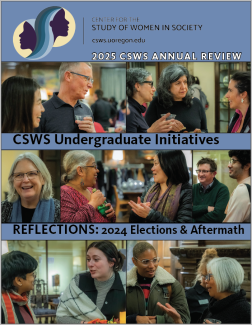Contents:
- A Year in Review by Sangita Gopal, Associate Professor, Department of Cinema Studies
- Encountering Women's History in a CSWS Calderwood Seminar by Jenée Wilde, Associate Teaching Professor, Department of English
- Personal Stories Inspire Summer Undergraduate Research Projects by Jenée Wilde, Associate Teaching Professor, Department of English
- Multimedia Spotlight
- Gender as Target: US 2024 Elections and Aftermath reflections by Sofia Vicente–Vidal, Liesl Cohn De León, and Vasil A. Arangelov
- Johnson Paintings Gifted to CSWS
- CSWS Holiday Party
- CSWS Open House
Faculty Research:
- Finding Edie X.: A Writer Explores Gender, Motherhood, and Disability through Art by Jori Celona, Associate Professor, Creative Writing Program
- A Queer History of Yiddish by Miriam Chorley-Schulz, Assistant Professor, German and Scandinavian Studies
Graduate Student Research:
- The Necessity of Oppositional Care for Transnational Feminist Politics by Rhiannon Lindgren, PhD Candidate, Department of Philosophy
- Dreams Deferred: Navigating Aspiration and Constraint in Urban India's Margins by Malvya Chintakindi, PhD Candidate, Department of Anthropology
- Gender, Social Politics, and Media Sensationalism in 19th-Century American Murder Ballads by Nat Ivy, Master’s Student, Folklore and Public Culture Program
- Migrant Memories: Community and Identity Building in a New Territory by Liesl Cohn De León, PhD Student, Department of Anthropology
- Social Reproduction and Palestine by Tali Bitton, PhD Candidate, Department of Philosophy
- It All Started with a Mirror: Questioning How We Assign Sex in Ancient Tombs by Yuan Fang, PhD Candidate, Department of Anthropology
- How to Love an Oyster: Chemistry, Slippage, and Attachment by Megan Hayes, PhD Candidate, Environmental Studies Program
- Trust in Women's Organizations: Evaluating Gender Gap and State Characteristics by Ruby Amanda Oboro–Offerie, PhD Student, Department of Sociology
- For a Good Cause: Chinese and Japanese American Girl Reserve Fundraising in 1930s Portland by Olivia G. Wing, PhD Candidate, Department of History
Highlights from the Academic Year:
- Outliers and Outlaws
- New CSWS Faculty Grant
- News & Updates
- 2025–26 CSWS Research Grant Award Winners
- Thank You to CSWS Donors
- Looking at Books
Articles

A Year in Review: 2024-2025
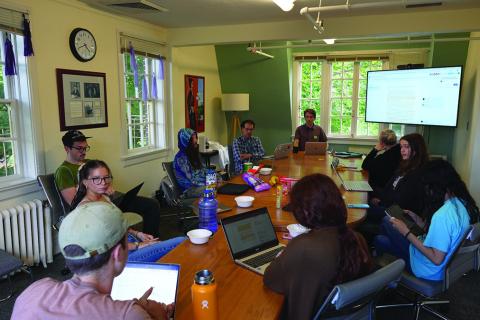
Encountering Women’s History in a CSWS Calderwood Seminar
In the Jane Grant Room at CSWS, a dozen students gather around the conference table as their instructor gets the workshop started. This week, classmates in group A are the editors, providing detailed critical and generative feedback to the op-ed writers in group B. Next week, their roles will be reversed.
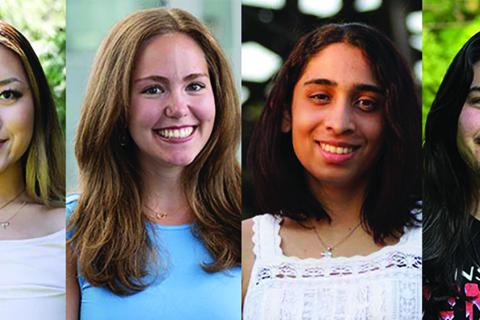
Personal Stories Inspire Summer Undergraduate Research Projects
The Center for the Study of Women in Society has launched a new student-centered research initiative—the CSWS Undergraduate STEAM Summer Fellowship. Over the summer, undergraduate fellows collaborated with University of Oregon faculty mentors to develop interdisciplinary research and creative projects that engage with STEAM fields—science, technology, engineering, arts, and mathematics. Our STEAM fellows approach their inquiry with gender and intersectionality as an analytical framework.

Gender as Target: US 2024 Elections and Aftermath

Johnson Paintings Gifted to CSWS
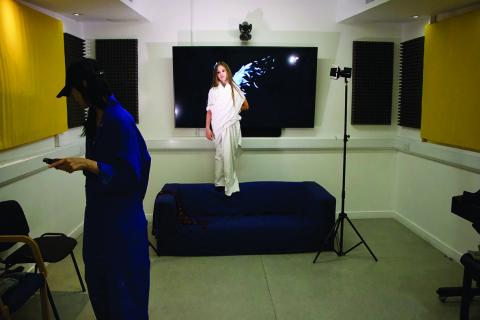
Finding Edie X. A Writer Explores Gender, Motherhood, and Disability through Art
My third novel, The Year of X, begins with Edie X., a mid-career artist, leaving her husband to attend a yearlong artist residency in upstate New York, bringing her young daughter, Lou, along for the ride. Her proposed project is a reimagining of Rembrandt’s The Anatomy Lesson of Dr. Nicolaes Tulp, in which she plans to document her own top surgery in a series of photographs. But shortly after arriving at the residency, she begins to have bizarre seizures, which hijack her life and art, and alter her sense of personhood in the world.

A Queer History of Yiddish
In their zine TimTum—A Trans Jew Zine (1999), Micah Bazant introduced an affirmative layer to the history of who is referred to in Yiddish as timtum (or tumtem). According to Bazant, a timtum is “a sexy, smart, creative, productive Jewish genderqueer.” This was not always the case.
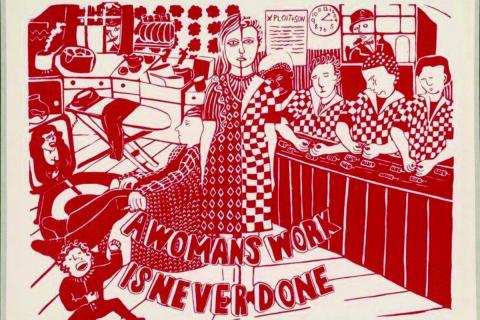
The Necessity of Oppositional Care for Transnational Feminist Politics
When one defines an activity as a “labor of love,” we are often referring to an experience that combines feelings of joy, difficulty, fatigue, and gratitude. While the labor of love is a sacrifice, the prepositional qualifier of “love” indicates the motivation for such a sacrifice. One labors out of a sense of love that is both inspiration and reward for a tiresome endeavor.
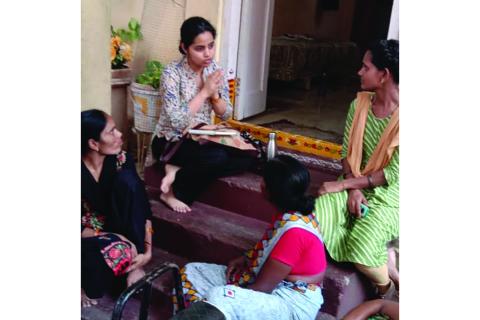
Dreams Deferred: Navigating Aspiration and Constraint in Urban India’s Margins
by Malvya Chintakindi, PhD Candidate, Department of Anthropology
At age 33, Renuka’s face carried the weathering of a life spent crossing multiple thresholds—between others’ homes and her own, between caste boundaries that marked her as both essential and polluting, between dreams of education and the harsh reality of survival.

Gender, Social Politics, and Media Sensationalism in 19th-Century American Murder Ballads
Murder ballads have been around for centuries. A murder ballad is a narrative song that tells the story of murder. However, as with any vernacular tradition, there’s a lot more to them than that. American murder ballads are most associated with Appalachian folk music, emerging in the early 19th century as Scottish and Irish immigrants made new homes in North America. As the century progressed, these Appalachian songs blended with African musical traditions, producing blues ballads.
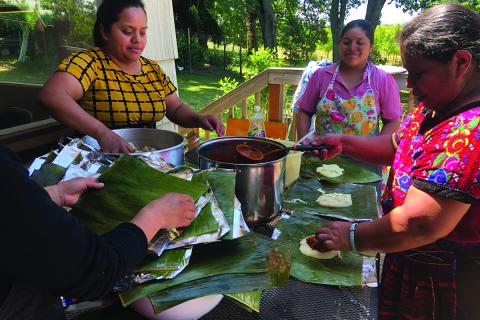
Migrant Memories: Community and Identity Building in a New Territory
By Liesl Cohn De León, PhD Student, Department of Anthropology
The Guatemalan migrant population in the United States has been growing in the last few decades. Although Guatemalans started coming to the US in the 1980s during the Guatemalan Civil War (1960–1996), between 2010 and 2020 the Guatemalan population increased by about 60%.1 According to the 2020 Census, about 1,683,093 Guatemalans live in the United States. However, there are estimates2 of at least 3,256,047 people from Guatemala living in the US.

Social Reproduction and Palestine
For many colonized women, gender-based violence (GBV) is never solely about their being women. When considering GBV within Palestine and Israel, like other forms of political violence, GBV functions as a mechanism of male supremacy within and across both peoples as much as a mechanism of settler colonization. But whereas Israel has a long history of documented GBV against Palestinians (as the UN has found occurred systematically in Israel’s current genocidal campaign in Gaza), the view of GBV within Israel is often presented in inverted form.
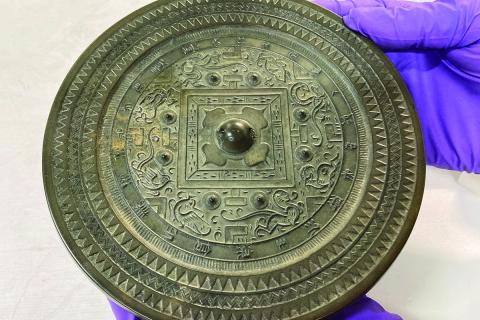
It All Started with a Mirror: Questioning How We Assign Sex in Ancient Tombs
One summer break back home in China, I visited the Henan Museum and found myself drawn to a bronze mirror on display. I had seen many before, but something about this one stopped me. Its delicate designs were beautiful, but I couldn’t stop thinking about what it meant. I pictured a Tang dynasty court lady using it for daily grooming—the familiar image often used to represent bronze mirrors as feminine tools tied to beauty.
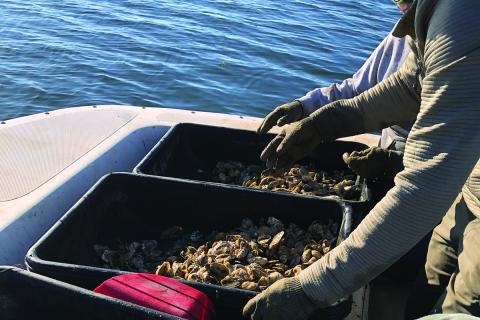
How to Love an Oyster: Chemistry, Slippage, and Attachment
by Megan Hayes, PhD Candidate, Environmental Studies Program
It was oysters who taught me about tides. Or, more precisely, it was oysters who taught me to give better attention to the tides. An oyster is a kind of bivalve, and bivalves are a class of aquatic mollusks that have, in the collective poetic descriptive of Wikipedia, “laterally compressed soft bodies,” which are enclosed in calcified exoskeletons made up of a hinged pair of half-shells, or valves.
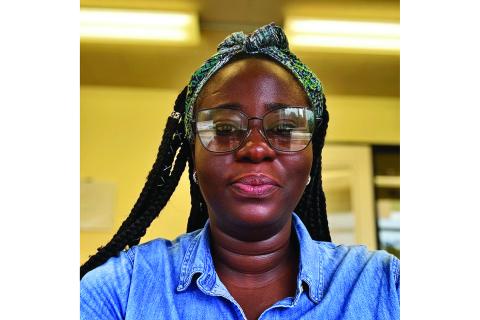
Trust in Women’s Organizations: Evaluating Gender Gap and State Characteristics
Public trust in institutions has long been a focus of social science research, yet most studies have concentrated on political institutions (Van Der Meer 2010), banks (Fungáčová et al. 2019), and regional (Ron and Crow 2015) and international organizations (Torgler 2008; Hessami 2011). In contrast, limited attention has been paid to trust in women’s organizations (e.g., women’s rights/empowerment groups or feminist movements), despite their growing role in civil society, global gender advocacy, and transforming social norms and gender power relations (Hassim 2006).

For a Good Cause: Chinese and Japanese American Girl Reserve Fundraising in 1930s Portland
In the late 1930s, Portland’s Chinese Girl Reserves and Japanese Girl Reserves each hosted a variety of fund-raising events to support causes of their choosing. Fundraisers were not unusual for a service organization sponsored by the YWCA. In the late 1930s, however, the Chinese and Japanese Girl Reserves each chose to sponsor seemingly diverging causes: war relief for Chinese refugees and summer camp, respectively.


